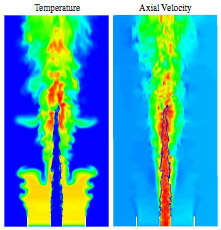
Abstract-
A consistent formulation of the G-equation approach for LES is developed. Since
the instantaneous unfiltered G-equation is valid only at the instantaneous flame
front location, in a filtering procedure, applied to derive the appropriate LES
equation, only states on the instantaneous unfiltered flame surface can be
considered. A new filter kernel is provided, which averages along the flame
surface. The filter kernal is used to derive the G-equation for the filtered
flame front location. This equation has two unclosed terms, involving a flame
front conditional averaged flow velocity, and a turbulent burning velocity. A
model for the conditional velocity is derived, expressing this quantity in terms
of the Favre-filtered flow velocity, which is usually known from the flow
solver. This model leads to the appearance of a density ratio in the propagation
term of the G-equation. Due to the application of the new filtering procedure,
also a propagation term proportional to the curvature of the mean front does no
longer appear. This is an important difference to earlier forms of the filtered
G-equation, since this term has a stabilizing effect on the flame front and will
therefore lead to a decreased resolved turbulent burning velocity.

 GALCIT Home Page
GALCIT Home Page
|
|